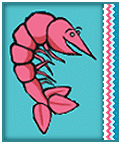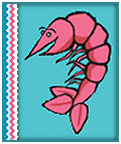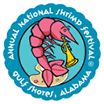Storing Shrimp:
Store fresh shrimp in the refrigerator at 32-38 degrees F and use within two days or store in freezer at 0° F and use within six months. Thaw shrimp in the refrigerator or under cold running water.
How shrimp are sold:
Shrimp are sized and sold by count (number of shrimp per pound) either whole or headless. For example, headless shrimp of 16-20 count means there are 16 to 20 headless shrimp per pound. Counts for headless shrimp range from under 10 (the largest shrimp) to 300-500 (teeny tiny).
How to Clean Shrimp:
There is an inexpensive plastic tool made that is handy for inserting into the shrimp's tail and ripping up and out in a quick motion to remove the 'vein' (read intestine) that runs the length of the shrimp. The one most commonly sold is red plastic, but there is a much better white plastic shrimp deveiner /cleaner /sheller in a little shop in Fairhope, Alabama called:
Village Peddler
418 Fairhope Ave
(across from Julwin's)
251 928-4850
and it is much better than the popular red one you see for sale most places. This one cost about $4 and worth every penny. With it you can clean the shrimp and still leave the shells on or easily remove the shells totally. If you live in some inland area, bless your heart, try inserting scissors along the top center of the tail shell back and snip it open to remove the 'vein'. Try cleaning shrimp in the sink with a small steady stream of running water for rinsing.
Boiled Shrimp:
Don't over cook them. Place a packet of shrimp/crab boil seasoning, a chunk of squeezed lemon and some salt (if cooking royal reds-don't salt the cooking water) in a big pot. Bring to a boil. Dump in the shrimp. As soon as the water returns to a boil, pour out the water and shrimp into a colander to stop the cooking.
If you are cooking shrimp of mixed sizes, use a slotted spoon to remove the smaller ones as soon as they begin to curl. Work quickly.
Serve with Cocktail Sauce that you make using:
- Good quality ketchup
- Some Heinz bottled Chili Sauce or a bit of dried chili powder
- Some fresh squeezed lemon juice
- Black pepper
- Dash of real Lee & Perrin's Worcestershire Sauce (not a cheap store brand)
- All the plain grated horseradish you can stand (not the creamed horseradish sauce with a mayonnaise or oil base)
- All the Tabasco sauce you can stand
In addition to the homemade cocktail sauce recipe above, could we suggest serving boiled shrimp with Zatarain's Remoulade Sauce ? |
Gulf Shrimp Info
Most shrimp spawn offshore in deep water from early spring through early fall. One female shrimp releases 100,000 to 1,000,000 eggs that hatch within 24 hours. Young shrimp are carried by currents into coastal estuaries to mature. By the time the young shrimp (postlarvae) reach the gulf passes and enter the bays, they are one-fourth inch long, transparent and have a shrimp-like appearance In the Gulf, shrimp are harvested with trawls which are cone-shaped nets towed along the bottom in waters near shore. Turtle excluder devices (TEDS) and by-catch reduction devices (BRDS) are used, as required by law, to minimize the capture of non-target marine turtles and fish.
Before Gulf shrimpers found out about trawling, they used long seines set close to shore and hauled by men or horses. Shrimp fishing was worthwhile only when white shrimp were abundant near the shore. By the 1940's, however, shrimp trawlers were a common sight at Gulf coast ports.
Once shrimpers were equipped with trawls, they could fish the dense shrimp stocks in deeper bay waters and the Gulf of Mexico. Improvements in transportation and refrigeration accompanied the growth of the shrimp trawl fishery and new markets opened. Today the modern Gulf trawler is a large, well-equipped seagoing vessel that can tow two or more large trawls at the same time.
Shrimp are sized and sold by count (number of shrimp per pound) either whole or headless. For example, headless shrimp of 16-20 count means there are 16 to 20 headless shrimp per pound. Counts for headless shrimp range from under 10 (the largest shrimp) to 300-500 (teeny tiny).
Shrimp are decapod crustaceans characterized by five pairs of legs, often with small pincers on the end. The first three pairs are used for walking. The head spine, walking legs and antennae are attached to the head section, while the edible portion (the "tail") bears the swimming legs and tail fan. They have large, well-developed eyes, and long antennae. Pink shrimp can vary in color from brown, yellowish, or pink. White shrimp are grayish-white with a green, red or blue tinge on the tail and legs. Royal red shrimp are usually deep red but are sometimes grayish pink. It sometimes takes an expert to tell shrimp species apart.
Many species of shrimp lead a dual life, spending the first part of their time inshore and the remainder in the open ocean. Hatched at sea, juvenile shrimp spend the early part of their lives as drifting oceanic plankton. Within 2 weeks after hatching, young shrimp become active swimmers. They instinctively move toward shore, navigating through inlets and into shallow estuarine nursery areas. The shrimp increase in size very rapidly, especially when water temperatures are warm. As the shrimp grow, they move gradually seaward, presumably in response to salinity. Near spawning time, adult shrimp move out of estuarine waters in large numbers (called "runs"), heading for inlets in order to return to the ocean to spawn.
Shrimpers eager to harvest them beginning when the shrimp are two to four months old and this continues for the rest of their lives--the shrimp that is ! If not caught by anglers or eaten by fish, they may live to be two years old. To grow, shrimp must cast off their shell and form another. They get larger before the new shell becomes firm. Shrimp grow rapidly when the water is 68 degrees F and above. If bay water temperatures fall below 60 degrees F, shrimp growth is much slower and at temperatures below 40 degrees F mortalities may occur.
Those Special Royal Reds
Royal Reds move up and down the continental shelf, preferring a specific temperature zone that is usually found around the 200-fathom curve (2400 feet deep). That can be 40-60 miles out from shore. Royal Red shrimpers work just inside the strongest flowing currents of the Gulfstream, enduring tides that average 3-5 knots. Royal Reds are also found about 100 miles west of Key West, as well as below the mouth of the Mississippi River. Fuel bills, naturally, for Royal Red shrimpers are much higher than those of inshore fishermen.
Adding risk, Royal Redders fish in major shipping lanes, continually dodging freighters as they work. The end product of their efforts has a unique taste and tender texture that you won't find in any other shrimp. Royal Reds are frozen onboard the ships and contain more salt than other shrimp so do not add salt to the water when you boil Royal Reds. |




